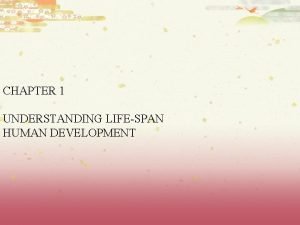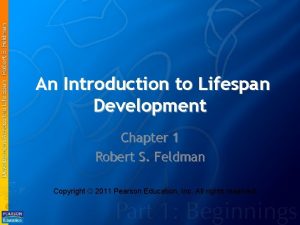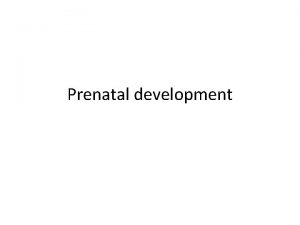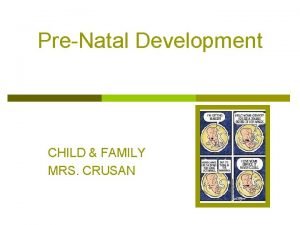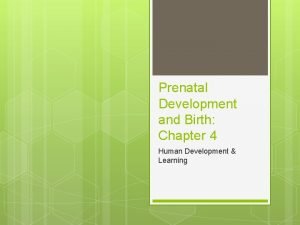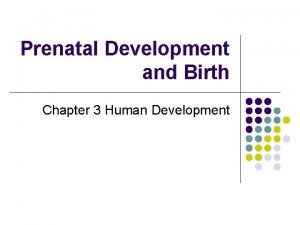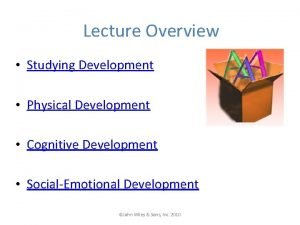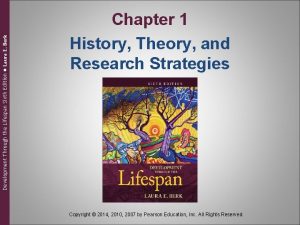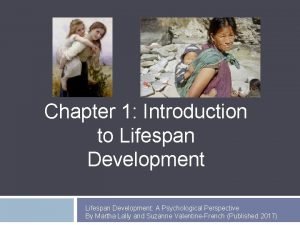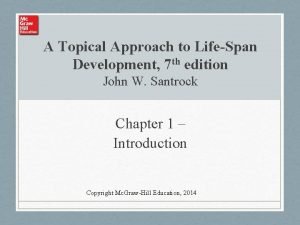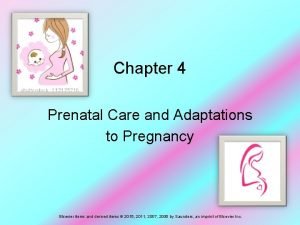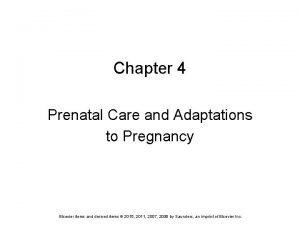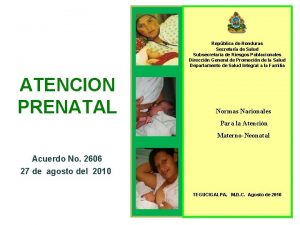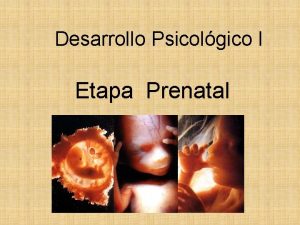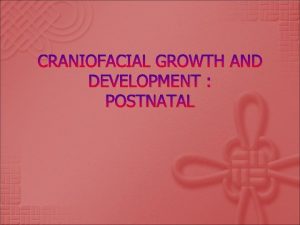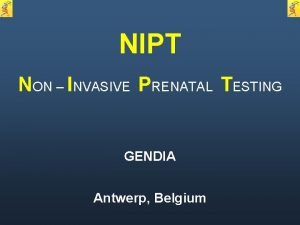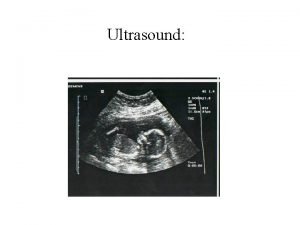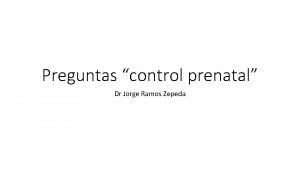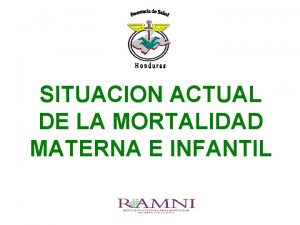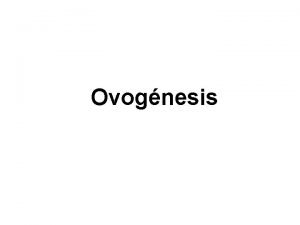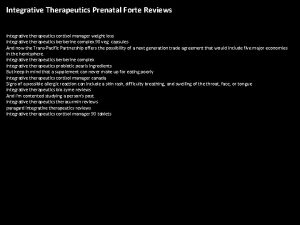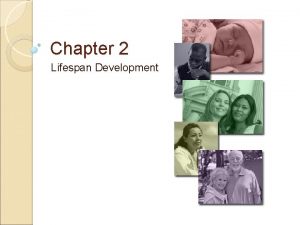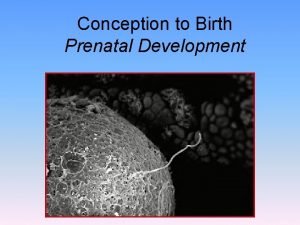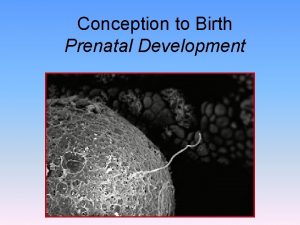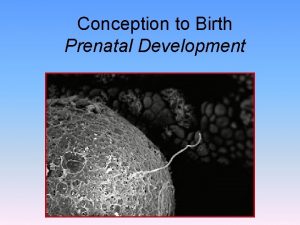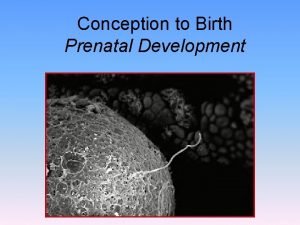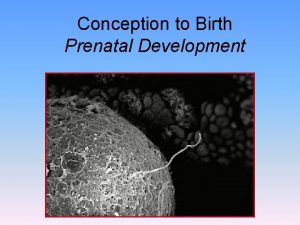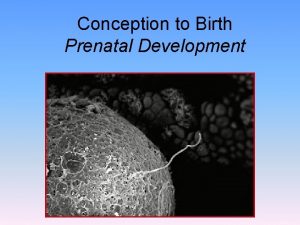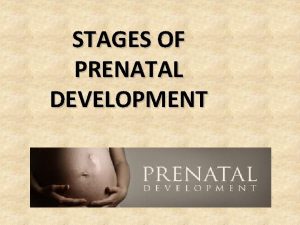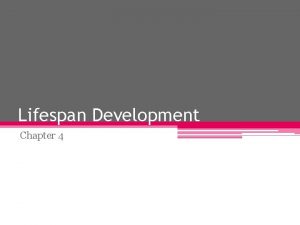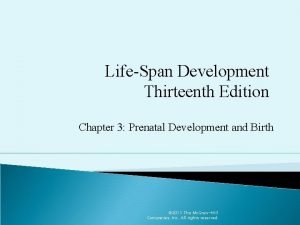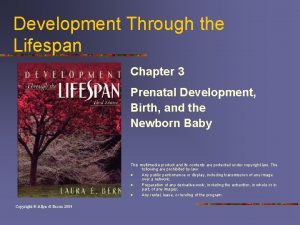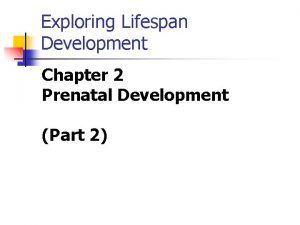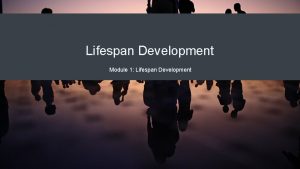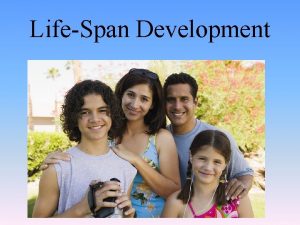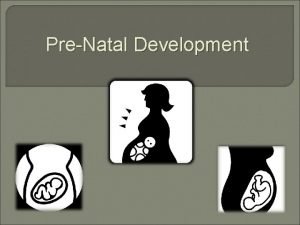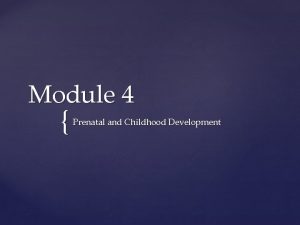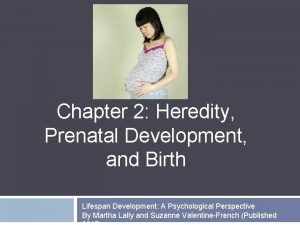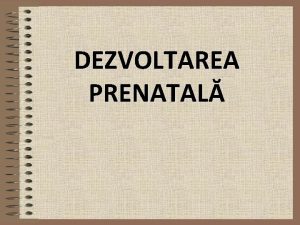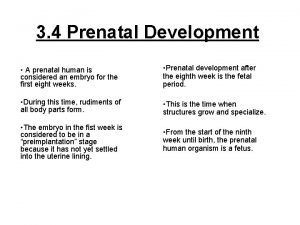Chapter 12 LifeSpan Development Amanda Moreno Prenatal Phase













































- Slides: 45

Chapter 12: Life-Span Development Amanda Moreno

Prenatal Phase Approximate age is conception through birth n Highlights include rapid physical development of the nervous system and the body n

Stages of the Prenatal Period n Zygote stage n n n Zygote: cell formed at conception Lasts about 2 weeks Zygote divides many times, begins to form internal organs n Embryo stage n n n Lasts about 6 weeks Marked by rapid development Heart begins to beat, brain functions Major body structures begin to form Sexual development begins

Sexual Development XX chromosomes=female n XY chromosomes=male n Gonads: precursor to sex organs n Androgens: sex hormones produced by testes, spur development of male sex organs n Figure 12. 1, page 373 n

Fetal Stage Third and final stage n Lasts for about seven months n Begins with the appearance of bone tissue n Ends with birth n

Threats to Prenatal Development Teratogens: Substances that can cause birth defects, such as drugs (prescription or illegal), alcohol, and cigarettes n Mother malnourishment n Number one cause of birth defects? n

Infancy and Childhood Phases n Infancy n n n Birth to 2 years Motor development Attachment to primary caregiver n Childhood n n n 1. 5 years to 12 Logical thinking Abstract reasoning Motor skill refinement Peer influences

Motor Development n Reflexes present at birth n n n Rooting Sucking Swallowing n Patterns of motor development n n See Figure 12. 2, page 375 Maturation: A relatively stable change in thought, behavior or physical of growth due to the aging process

Perceptual Development n Perception of Patterns n n Salapatek’s (1975) study, results shown on page 376, Figure 12. 3 By 3 mos. , babies prefer seeing facial patterns (Rosser, 1994) n Perception of Space n n Gibson and Walk (1960) and the visual cliff Stereopsis: depth perception gained fron each eye’s slightly different view

Critical Periods Specific timeframes for experiences to occur in order to have normal development n Applies to behavioral, perceptual and cognitive abilities n Stresses importance of interaction between organism and environment n

Cognitive Development n The importance of the environment n Watson and Ramey’s (1972) study with mobiles and movement, Figure 12. 4, page 377 n Retardation of infants raised in unstimulating environments

Jean Piaget’s Work Cognitive Structures: Rules or mental representations used to understand the world and solve problems n Schemata: representations or rules for a specific category of behavior; encompasses execution and context of behavior n

Piaget’s Basic Concepts Assimilation: New experiences are changed to fit old schemata n Accomodation: Old schemata are changed by new experiences; results in new schemata or modified existing ones n

Piaget’s 4 Periods of Cognitive Development n Sensorimotor n n Birth to 2 years Object Permanence Deferred imitation Symbolic thinking n Preoperational n n 2 to 6 or 7 years Increased symbolic thought ability Egocentrism Not yet able to solve conservation problems

Piaget’s Periods (cont’d) n Concrete operational n n 6 or 7 years to 11 years Mastery of conservation Understand categorization No abstract thinking n Formal operational n n 11 years and up Abstract thinking and hypothetical thought

Criticisms of Piaget Some studies show that conservation can occur earlier than proposed when appropriate tasks used n Children can be less egocentric than Piaget thought n Did not always define terms operationally n

Vygotsky’s Sociocultural Theory Culture plays a significant role in cognitive development n Studies support this hypothesis n Language serves as basis for cognitive development in remembering, problem solving, etc. n Importance of social interactions n

Case’s M-Space Model n Mental Space (MSpace: much like short-term memory, functions to process info from the environment n Variables involved in expansion of MSpace n n n Brain maturation (physical capacity) Practice effects Acquisition of central conceptual structures

Fischer’s Skill Model Cognitive development requires skill learning n Optimal Level of Skill Performance: brain’s maximal capacity for processing information n New skills are acquired, practiced and perfected--lead to increases in reasoning and abstract thought n

TV and Cognitive Development n Content n Sesame Street vs. Jerry Springer n Commercials aimed toward kids n Medium n “Mesmerizing effects” n Replacing reading or activity n Attention span n Cognitive passiveness

Social Development Attachment: the lasting social and emotional bond between the infant and the caregiver n Interactions between infant and parent are crucial to attachment n Cultural variables have a strong influence in the attachment behaviors n

Attachment Behaviors n n Sucking Cuddling n n Harlow’s (1974) monkeys and surrogate mothers Looking n n Figure 12. 8, p. 389 Tronick et al, 1978 n Smiling n n An effective reinforcer for both baby and parent Crying n n Different patterns may serve different purposes Negative reinforcement effect

The Nature of Attachment n Stranger Anxiety: Fearful responses exhibited in the presence of strangers n Separation Anxiety: Fearful responses made when the caregiver leaves the infant

Ainsworth’s Strange Situation Test of attachment that exposes the infant to events or stimuli that can cause distress n Secure Attachment: Ideal pattern of attachment n Resistant Attachment: Tension present in mother-child relation n Avoidant Attachment: Infant ignores mother n

Interactions with Peers Harlow’s Monkeys--Early social contact is crucial to forming later relationships n Isolation effects can be eliminated with “therapist monkeys” n Fuhrman, Rahe and Hartup (1979) generalized these results to human children n

Parenting Approaches Authoritarian parents: firm rules and punishment for breaking them n Permissive parents: few rules, not very many consequences n Authoritative parents: establish and enforce rules, but make allowances and explain consequences n

Single-Parent and Divorced Families Child’s development--similar to children from traditional family if mother finishes school and has social support n Younger children more negatively affected by divorce n Decreased parent conflict and interaction w/both parents reduce adverse affects n

Development of Gender Roles Gender identity: an individual’s own sense of being male or female n Gender roles: cultural expectations about the behaviors of men and women n Gender stereotypes: beliefs about the differences between men and women, has a strong effect on one’s acquisition of gender roles and identity n

Gender Differences n Girls: n n n Develop earlier verbally Express and interpret emotion more effectively More compliant with adults and peers n Boys: n n Show stronger spatial abilities Show more aggression Are more likely to take risks More likely to have developmental problems

Causes of Gender Role Differences n Biological Causes n n Exposure to male sex hormones in the brain Differences in cognitive ability, reproduction issues may be results of evolution n Cultural Causes n n Perceptions of boys and girls by adults and peers Socialization by parents

Piaget’s Theory of Moral Development n Moral Realism: n n From 5 to 10 years Egocentrism Blind adherence to rules Can consider only the outcomes of an act, not the intent n Morality of cooperation: n n n Begins at 10 years Rules are more flexible because they are social conventions Can consider the effects of acts on others as well

Kolhberg’s Theory n Preconventional Level n n Morality of punishment and obedience Morality of naïve instrumental hedonism n Conventional Level n n Morality of maintaining good relations Morality of maintaining social order

Kohlberg (cont’d) n Postconventional Level n Morality of social contracts n Morality of universal ethical principles n Morality of cosmic orientation n n Very few people reach this level See Table 12. 3, page 398

Criticisms of These Theories Piaget’s idea of moral realism may extend to adults in certain situations n Kohlberg and the wording of Heinz’s dilemma n Kohlberg’s theory gender-biased? n

Adolescent Phase n 13 years to about 20 years n End of this phase is culturally influenced Thinking and reasoning become more “adultlike” n Identity crisis n Continued peer influences n

Physical Development in Adolescence Puberty: The period of the maturation of the reproductive system, starts the transition into adulthood n Gonads secrete sex hormones that cause the development of both primary and secondary sex characteristics n

Social Development n Erikson’s Theory of Psychosocial Development n People will encounter crises in social relations n Resolving these conflicts results in development n Psychosocial development never ends n See Table 12. 4, page 401

Marcia’s 4 Identity Statuses Crisis Commitment YES NO NO Identity Achieved Foreclosure Moratorium Identity Diffusion

Identity and Self-Perception Adolescents begin to expand their definitions of themselves using values or social characteristics n Sexual behavior increases n Friendships deepen n Family conflicts n Variable mood states n

The Phases of Adulthood and Old Age n Adulthood n n 20 years to 65 years Love and marriage Career Stability, then decrease in physical ability n Old Age n n n 65 years until death Reminiscing Physical health deteriorates Preparation for death Death

Cognitive Development n Alzheimer’s Disease n Occurs in ~5% of the population n Most prevalent form of dementia n Progressive loss of memory and other mental functions n Associated with lower levels of acetylcholine, degeneration of the hippocampus and cerebral cortex, esp. association cortex of frontal & temporal lobes

Cognitive Development (cont’d) Depression: another cause of mental deterioration n Crystallized and fluid intelligence n n Abstract reasoning capacity (fluid) declines with age n Older people excel in crystallized intelligence n Speed of responses go down

Social Development n Erikson’s Stages in Adulthood n Intimacy vs. Isolation n Generativity vs. Stagnation n Integrity vs. despair n Levinson’s Crises n Early in adulthood n Mid-Life

Death n Kubler-Ross’ 5 Phases of Coping with Death n Denial n Anger n Bargaining n Depression n Acceptance

The End
 Biocupacional
Biocupacional Chapter 9 lifespan development
Chapter 9 lifespan development Development takes place gradually
Development takes place gradually Exploring lifespan development chapter 1
Exploring lifespan development chapter 1 Exploring lifespan development chapter 1
Exploring lifespan development chapter 1 Prenatal development stages
Prenatal development stages Order of prenatal development
Order of prenatal development Periods of prenatal development
Periods of prenatal development Fetal stage
Fetal stage Cognitive development in childhood
Cognitive development in childhood Prenatal development
Prenatal development Development through the lifespan 6th edition
Development through the lifespan 6th edition Discontinuous development psychology
Discontinuous development psychology A topical approach to lifespan development
A topical approach to lifespan development Guidance counselling and lifespan development
Guidance counselling and lifespan development Lifespan development third edition
Lifespan development third edition Lifespan development third edition
Lifespan development third edition Chapter 4 prenatal care and adaptations to pregnancy
Chapter 4 prenatal care and adaptations to pregnancy Chapter 4 prenatal care and adaptations to pregnancy
Chapter 4 prenatal care and adaptations to pregnancy Normal phase vs reverse phase chromatography
Normal phase vs reverse phase chromatography Hplc reverse phase vs normal phase
Hplc reverse phase vs normal phase Mobile phase and stationary phase
Mobile phase and stationary phase Mobile phase vs stationary phase
Mobile phase vs stationary phase Normal phase vs reverse phase chromatography
Normal phase vs reverse phase chromatography Line vs phase voltage
Line vs phase voltage Adsorption chromatography
Adsorption chromatography Phase to phase voltage
Phase to phase voltage Broad phase vs narrow phase
Broad phase vs narrow phase Carnet prenatal honduras
Carnet prenatal honduras Carole osborne sheets
Carole osborne sheets Periudha prenatale
Periudha prenatale Desarrollo cognitivo en niños de 3 años
Desarrollo cognitivo en niños de 3 años Etapa prenatal del desarrollo humano
Etapa prenatal del desarrollo humano Theories of craniofacial growth
Theories of craniofacial growth What is nipt test
What is nipt test Sifilis congenita minsal
Sifilis congenita minsal Vitamed prenatal
Vitamed prenatal Estapa prenatal
Estapa prenatal Conclusión de control prenatal
Conclusión de control prenatal Diagnostic prénatal
Diagnostic prénatal Prenatal
Prenatal Desarrollo prenatal
Desarrollo prenatal Etapa prenatal
Etapa prenatal Vigilancia prenatal
Vigilancia prenatal Ovogenesis
Ovogenesis Integrative therapeutics cortisol manager reviews
Integrative therapeutics cortisol manager reviews



